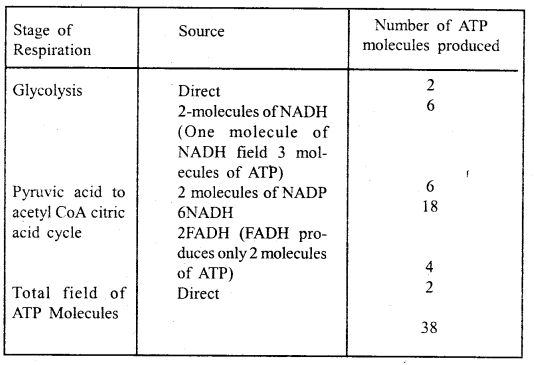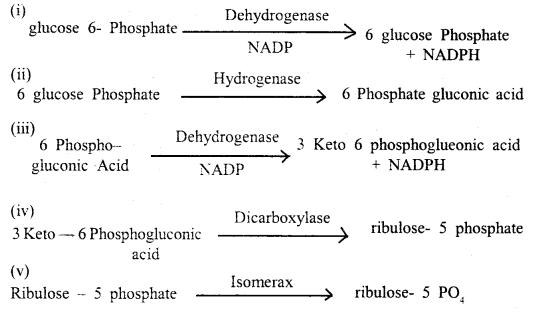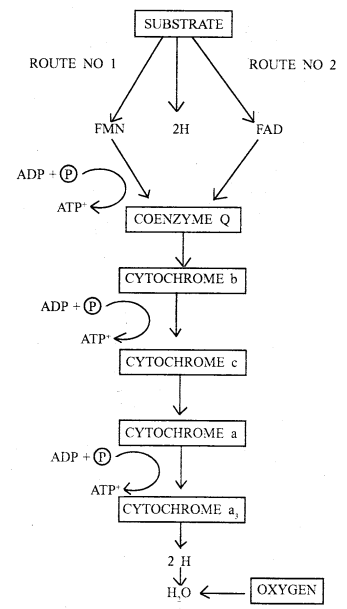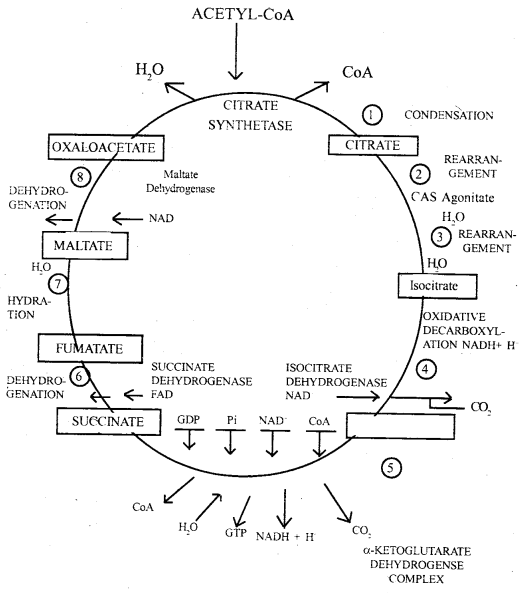Chapter 14 Respiration In Plants
Class 11th Biology Important Questions
Class 11 Biology Chapter 14 Important Extra Questions Respiration in Plants
Respiration in Plants Important Extra Questions Very Short Answer Type
Question 1.
Whether respiration is a catabolic or anabolic process?
Answer:
Catabolic (destructive)
Question 2.
Name the cell organelle where cellular respiration takes
place.
Answer:
Mitochondria
Question 3.
Give the chemical equation for aerobic respiration.
Answer:
C6H12O6 + 6O2 →
6H2O + 6CO2 + 686 kcal.
Question 4.
Name the substance that is oxidized during respiration.
Answer:
Glucose
Question 5.
What is fermentation?
Answer:
Respiration by
microorganisms without the utilization of oxygen is called fermentation.
Question 6.
What is the main source of energy?
Answer:
Carbohydrates, lipids, and proteins.
Question 7.
In what form the energy released by oxidation is stored in the
body?
Answer:
In the high-energy bonds of ATP molecules.
Question 8.
Name two respiratory, mediums for living beings.
Answer:
Air and water.
Question 9.
What is cell respiration?
Answer:
Enzymatic oxidation of
food in body cells is known as cell respiration.
Question 10.
What holds the energy in the body?
Answer:
Molecules of
food hold energy in their chemical bonds.
Question 11.
Name some industrial products of fermentation.
Answer:
Wine, Alcohol, Vinegar, Bread, etc.
Question 12.
Define anaerobic respiration.
Answer:
Respiration
carried out in the absence of oxygen is called anaerobic respiration.
Question 13.
Define RQ is words
Answer:
RQ is the ratio between the
amount of CO2 evolved to the amount of oxygen used.
Question 14.
How is oxygen distributed in the plant body?
Answer:
By
diffusion from a cell of the cell.
Question 15.
Name the parts of the plant body that allow the exchange of
gases.
Answer:
Lenticels, stomata, and general body surface.
Question 16.
How many ATP molecules are produced in aerobic
respira¬tion?
Answer:
36
Question 17.
When a molecule like that of
C6H12O6 is oxidized completely, what are its
end products?
Answer:
CO2 and water,
Question 18.
Name two Anti-transpirants.
Answer:
Abscisic acid,
Phenyl mercuric acetate.
Question 19.
What metal element is involved in the movement of
stomata?
Answer:
Potassium
Question 20.
Why is respiration necessary for the plant?
Answer:
Respiration is necessary as it releases the energy which is used for daily
activities.
Question 21.
Why is less energy released during anaerobic respiration?
Answer:
During anaerobic respiration, food is incompletely oxidized and so
less energy is released.
Question 22.
What is fermentation?
Answer:
Anaerobic respiration by
some microbes is called fermentation.
Respiration in Plants Important Extra Questions Short Answer Type
Question 1.
What is respiration?
Answer:
A process of physiochemical
change by which environmental oxygen is taken in to oxidize the stored food or
release CO2, water, and energy. The energy released is used for doing
various life activities, whereas CO2 being is used by the plants for
their growth and development.
Question 2.
Define aerobic respiration.
Answer:
The process of
release of energy through intake of molecular oxygen and release of
CO2 is known as Aerobic respiration.
Question 3.
Define the process of fermentation showing chemical
equation.
Answer:
In this process, the carbohydrate is incompletely
oxidized into some carbonic compounds such as ethyl alcohol, acetic acid, lactic
acid, and CO2. This process of oxygen being carried out in microbes
is known as fermentation.
C6H12O6 → 2
C2H5OH + Energy (247 kJ).
Question 4.
On what factor the respiratory quotient depends?
Answer:
The ratio of the volume of CO2 evolved to the volume of
O2 consumed in respiration is called the respiratory quotient
RQ (the respiratory quotient) depends upon the type of respiratory substrate used during respiration. This is different for different substrates.
Question 5.
What is a citric acid cycle?
Answer:
This is also known
as the Tricarboxylic acid cycle. When acetyl CO- A enters into a reaction to
form citric acid and how pyruvate is broken down during metabolism is
highlighted by the concept of cycles. This series of reactions is known as the
citric acid cycle.
Question 6.
What will be the value of RQ when organic acids are used as
respiratory substrate?
Answer:
Organic acids contain more oxygen than carbohydrates; therefore the
RQ is more than one. Less amount of oxygen is required for their oxidation.
Question 7.
How many types of respiration occur in plants?
Answer:
Depending upon the availability of oxygen, respiration is of two types.
- Aerobic respiration
- Anaerobic respiration.
Aerobic respiration: Complete oxidation of organic substances in presence of
oxygen takes place.
Anaerobic respiration: This type of respiration takes
place in the complete absence of oxygen.
Question 8.
Describe the process of glycolysis and where it occurs.
Answer:
Glycolysis is the first stage of breakdown of glucose and common in
all organisms. In anaerobic organisms, it is only the process of respiration. In
this process, glucose undergoes partial oxidation. This process occurs in the
cytoplasm of the cell.
Question 9.
What is the role of the citric acid cycle?
Answer:
- Carbon skeletons are obtained for the growth and maintenance of the cell during this cycle.
- Many intermediate compounds are formed which are used in the synthesis of biomolecules like amino acids, fats, etc.
- ATP molecules having high energy are generated during this pathway.
Question 10.
What is a compensation point?
Answer:
At a low
concentration of CO2 and non-limiting light intensity, the
photosynthetic rate of a given plant will be equal to the total amount of
respiration. The atmospheric concentration of CO2 at which
photosynthesis just compensates for respiration is referred to as the
CO2 compensation point.
Question 11.
Write the significance of the citric acid cycle.
Answer:
During this pathway, carbon skeletons are obtained for use in the
growth and maintenance of the cell. Many intermediate compounds are formed,
which are used in the synthesis of other biomolecules like amino acids,
nucleotides, chlorophyll cytochromes, and fats.
Question 12.
Why does anaerobic respiration produce less energy than
aerobic respiration?
Answer:
Because it does not involve the use of
molecular oxygen. Food is not completely oxidized to CO2 and waste.
So a lot of energy is still retained with the food. Less energy is produced on
anaerobic respiration. It yields only about 5% of the energy available in
glucose. Then it is a wasteful process or respiration. In anaerobic respiration,
yeast metabolizes glucose to ethanol and CO2 without any use of
molecular oxygen.
Question 13.
What is oxidative phosphorylation?
Answer:
Glucose is
completely oxidized by the end of the citric acid cycle but the energy is not
released unless NADH and FADH are oxidized. Oxygen acts as the final hydrogen
acceptor. The whole process by which oxygen effectively allows the formation of
ATP molecule by phosphorylation of ADP is called oxidative phosphorylation.
Question 14.
Fill in the blanks with suitable words.
Answer:
(a)
Pyruvic acid oxidized into CO3 and H2O before entering the
citric acid cycle.
(b) The RQ is more than one if the respiratory substrate
is oxalic acid.
(c) Glycolysis takes place in crystal.
(d) The acetyl —COA
is accepted by Coenzyme A (a sulfur-containing compound).
Question 15.
Explain the effects of temperature on the rate of
respiration.
Answer:
Respiration is reduced at very high (above 50°c) and
very low (near freezing temp.) temperatures. This is because enzymes can work
best between 30°c – 40°c and get inactivated at very high and very’ low
tempera¬tures.
Question 16.
How does the exchange of respiratory gases occur in
plants?
Answer:
The gaseous exchange takes place through
- General body surface
- Lenticels.
- Stomata present in leaves and young stems. Oxygen becomes transported from cell to cell by diffusion.
Question 17.
Explain RQ significance.
Answer:
RQ value for
carbohydrates is 1. It is less than one if proteins are being burnt and more
than one if fats are being burnt. So RQ values are important in identifying the
kind of substrate used in respiration.
Question 18.
Describe in detail the aerobic oxidation of pyruvic acid.
Answer:
Pyruvic acid generated in the crystal is transported to mitochondria
and initiates the second phase of respiration. Before pyruvic acid enters the
Kreb’s cycle, one of its three carbon atoms is oxidized to carbon dioxide in the
reaction called oxidative decarboxylation.
Pyruvate is first decarboxylated and then oxidized by the enzyme pyruvate
dehydrogenase. The combination of the remaining two-carbon acetate unit is
readily accepted by a sulfur-containing compound coenzyme A to form acetyl COA.
During the process, NAD is reduced to NADH. This process is represented
as.
During this process, two molecules of NADH are produced, and
thus, it results in a net gain of 6ATP molecules.
(2 NADH + 3 = 6 ATP). 2 molecules of pyruvic acid produced during glycolysis,
Question 19.
Describe the net gain of ATP during respiration.
Answer:
There is a gain of 36 ATP molecules during aerobic respiration of one
molecule of glucose. The detail is given in the table.
In most eukaryotic cells, 2 molecules of ATP are required for transporting the NADH produced in glycolysis into mitochondrial for further oxidation. Hence, the net gain of ATP is 36 molecules.
Table ATP molecules produced during respiration.
Question 20.
Define the following:
(a) Respiration
Answer:
Respiration: It is defined as the phenomenon of the release of energy by
oxidation of various organic molecules, for cellular use is known as
respiration.
(b) Respiratory substrate
Answer:
Respiratory substrate: The compounds
that are oxidized during the process of respiration are called respiratory
substrates.
(c) Respiratory quotient
Answer:
Respiratory quotient: During
respiration oxygen is used and CO2 is released. The ratio of the
volume of CO2 evolved to the volume of O2 consumed in
respiration is called respiratory quotient (RQ).
(d) Anaerobic respiration
Answer:
Anaerobic respiration: The type of
respiration, in which the carbohydrate is incompletely oxidized into some
carbonic compounds in absence of oxygen, is called Anaerobic respiration.
(e) Aerobic respiration
Answer:
Aerobic respiration: It is that process
of respiration which leads to complete oxidation of organic compound in the
presence of oxygen.
This type of respiration is common in higher organisms.
(f) Fermentation.
Answer:
Fermentation: In anaerobic respiration yeasts
metabolize glucose to ethanol and CO2 without any use of molecular
oxygen. This process is called fermentation in yeasts.
Question 21.
Describe the pentose phosphate pathway.
Answer:
Sometimes oxidation of glucose takes place by another pathway, which is called
the pentose phosphate pathway (PPP). In the pentose pathway, glucose-6 phosphate
(6C) produced during the early stages of glycolysis or the photosynthates
produced during photosynthesis are oxidized to give rise to 6-phosphogluconate.
This reaction takes place in the enzyme glucose 6phosphale dehydrogenase and
generates NAD PH.
The 6-phosphoglucose molecules are further oxidized by the enzyme
6-phosphogluconate dehydrogenase. As a result of this, one molecule of each
ribose-5 phosphate, carbon dioxide, and NADPH is produced, which in turn
undergoes many changes to produce glycolytic intermediate. These reactions take
place in the cytoplasm.
(From glycolysis)
Question 22.
Calculate the efficiency of respiration in the living
system.
Answer:
During aerobic respiration, O2 is consumed and
CO2 is released. The ratio of the volume of CO2 evolved to
the volume of O2 consumed in respiration is called respiratory
quotient (RQ) or respiratory ratio.
The RQ (respiratory quotient) depends upon the respiratory
substrate. When a carbohydrate is used as a substrate.
C6H12O6 – 2C2H5OH +
2CO + Energy (247 K.J) on complete oxidation. RQ will be
The total energy yield from 38 ATP molecules comes to 1298
kJ. The energy released by one molecule of glucose on complete oxidation is 2870
kJ. Thus, the efficiency is 45%. Much of the energy generated during respiration
is released in the form of heat.
Respiration in Plants Important Extra Questions Long Answer Type
Question 1.
Illustrate the mechanism of the electron transport system.
Answer:
The glucose molecule is completely oxidized by the end of the citric
acid cycle. But the energy is not released unless NADH and FADH are oxidized
through the electron transport system. Here oxidation means the removal of
electrons from it.
The metabolic pathway through which the electron passes from one carrier to another is called the electron transport system (ETS) and it is operative in the inner mitochondrial membrane. Electrons from NADH produced in the mitochondrial matrix are oxidized by an NADH dehydrogenase (Complex I) and electrons are then transferred to ubiquinone.
The ubiquinone located within the inner membrane also receives reducing equivalents via FADH, which is generated during the oxidation of succinate, through the activity of the enzyme, succinate dehydrogenase (complex II). The reduced ubiquinone is then oxidized with the transfer of electrons to the cytochrome complex (Complex III).
Cytochrome is a small protein attached to the outer surface of the inner membrane and acts as a mobile carrier for the transfer of electrons between complex III and complex IV.
(Complex IV) is cytochrome.
When the electrons pass from one carrier to another via complex 1 to IV in the electron transfer chain, they are coupled to ATP synthase (Complex V) for the production of ATP from ADP and inorganic phosphate. Oxidation of one molecule of NADH gives rise to 3 molecules of ATP, while that of one molecule of FADH, produces 2 molecules of ATP.
The electrons are earned by the cytochromes and recombine with their protons before the final stage when the hydrogen atom is accepted by oxygen to form water. Oxygen acts as the final hydrogen acceptor. The whole process by which oxygen allows the production of ATP by phosphorylation of ADP is called oxidative phosphorylation.
Note: There are two routes by which hydrogen from the substrate molecule passes. In route 1.3 ATP molecules are formed for every pair of hydrogen atoms. In route 2, only 2ATP molecules are formed from one pair of hydrogen atoms.
Oxygen acts as the final hydrogen acceptor and forms water.
NAD =
nicotinamide adenine dinucleotide.
MN = flavin mononucleotide,
FAD =
flavin adenine dinucleotide.
ETC produces 32 ATP molecules per glucose molecule and is the major source of
cell energy.
Electron Transport Chain.
Question 2.
Describe the process and role of the citric acid cycle in
living organisms.
Answer:
In the process of respiration, the carbohydrates
are converted into pyruvic acid through a series of enzymatic reactions. These
reactions are known as glycolysis and take place in the cytosol. The pyruvic
acid thus formed enters in mitochondria where O2 and necessary
enzymes are available; the pyruvic acid is finally converted into CO2
and H2O. This reaction series is known as Krebs Cycle or Citric acid
cycle or Tricarboxylic acid (TCA) cycle.
During this cycle, 3 molecules of NAD and one molecule of FAD (Flavin Adenine
Dinucleotide) are reduced to produce NADH and FADH respectively. NADH and FADH,
so produced during the citric acid cycle are linked with the electron transport
system and produce ATP by oxidative phosphorylation, The summary equation for
this phase of respiration may therefore be written as follows:

Kreb’s cycle. It follows glycolytic reactions shown in and
pyruvate oxidation.
It involves two processes
- removal of hydrogen and
- the breaking off of carbon dioxide units one by one.